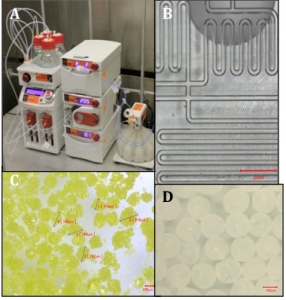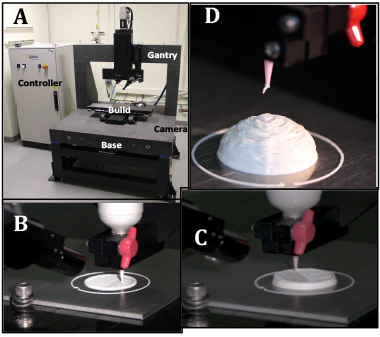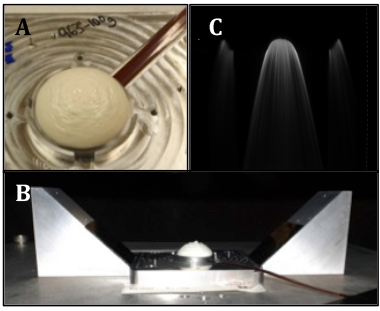Alexander Gash (13-ERD-051)
Abstract
Our objective with this project was to develop the methodology and expertise for additive manufacturing of plastic-bonded explosive components. This material is a composite of predominately explosive crystals bonded together with a small amount of polymer. Our research enables manufacturing of plastic-bonded explosives by a totally new method that allows exquisite spatial density and compositional control within a single monolithic component, which is not possible with current methods. We used experimental and predictive methods to understand the science behind particle synthesis in micro-reactors that enable continuous synthesis operations in micro-machined channels. We also evaluated development of high-solids, high-density colloids as candidate materials for formulation of plastic-bonded explosives. Flow-chemistry micro-fluidic processing was applied to the synthesis and crystallization of the energetic materials using two important reaction classes: nitration and oxidation. In one case, we determined the optimal conditions for continuous nitration of a precursor molecule to produce the high-explosive LLM105 and scaled up to 25 g of material in one session. In another case, the oxidation of a precursor molecule was executed to prepare the explosive LLM172. Using a micro-fluidic device, we achieved crystallization of energetic materials by utilizing anti-solvent precipitation and melt droplet formation, respectively. Energetic materials produced via flow chemistry and crystallization were used to create a plastic-bonded explosive shear-thinning ink for three-dimensional printing by direct ink-write printing, an additive manufacturing technique in which a filament of "ink" is extruded from a nozzle, forming an object layer by layer. Several candidate high-explosives-containing inks were formulated, characterized, and printed that contained high solids loading (94% high explosives by weight) and were used to produce printed plastic-bonded explosive structures with theoretical maximum densities as high as approximately 93%. Selected plastic-bonded explosive structures were tested for detonation capability, breakout timing, and detonation velocity. Those measured quantities were consistent with materials produced from the same source material by current methods. The breakout surface timing of the parts was highly variable, likely a result of the highly variable smoothness of the output surface on the structure printed with the direct ink-write process.
Background and Research Objectives
The properties and functionality of engineered composite materials are dictated by the composition and spatial arrangement of constituents. It is often the case that there are conflicting functional requirements. Attractive solutions to such challenges include the use of new processing routes.1,2 More specifically, micro-reactor synthesis and additive manufacturing techniques such as direct ink writing have been instrumental in realizing the potential of materials-architecture manipulation.3–6 (Direct ink-write printing describes fabrication methods that employ a computer-controlled translation stage upon which an ink-deposition nozzle writes materials with controlled architecture and composition.)
One class of composite materials not yet significantly impacted by advanced manufacturing techniques are plastic-bonded explosives. This material is a composite of explosive crystals bonded together with a small amount of polymer.7 The functionality of such explosives and manufacturing concerns are encountered in the weapons complex as the current stockpile ages and undergoes lifetime extension programs. Engineering and initiation-energy limitations for future lifetime-extension programs necessitate new explosives with tailored properties. A capability to produce custom high-explosive feedstocks and plastic-bonded-explosives components with tailored functionality will enable more flexibility in future programs. Current methodology leads to plastic-bonded explosives in the stockpile that have development times of decades, because of problems associated with materials scale-up.8–10 We addressed these issues by initiating a paradigm shift in explosives manufacturing for future national applications.
A primary goal of this project was to develop the methodology and expertise to enable additive manufacturing of plastic-bonded-explosives components. We accomplished this goal using novel materials synthesis, crystallization, and processing methods. These methods allow the preparation of starting materials with prescribed particle size, morphology, and composition in a continuous fashion. Advanced additive manufacturing methods are then applied to plastic-bonded explosives to engineer the assembly into macroscopic (millimeter- to centimeter-sized), detonable structures. The understanding and expertise established in this project enables future plastic-bonded-explosives components to be fabricated through an additive process with unprecedented control of spatial density and composition. We have established the groundwork for future programmatic efforts to use this exclusive capability to address future national needs involving energetic materials.
The specific objectives of the project were to (1) optimize continuous flow-chemistry (nitration and oxidation reaction classes) processing conditions for the synthesis of high-explosive molecules, (2) demonstrate a micro-fluidic approach to the continuous formation of high-explosive crystals with controlled size, (3) utilize flow-chemistry-derived high explosives in a formulated ink for direct ink-write printing, (4) use direct ink write to print high-solids-loaded high-explosive ink (>80% high explosive by weight), and (5) print high-density (>90% theoretical maximum density) plastic-bonded-explosive structures by the direct ink-write process.
All of the research objectives were addressed in this study, and if not completely met, a more complete understanding of the important scientific parameters surrounding them was achieved.
Scientific Approach and Accomplishments
A chemical flow reactor is a micro-fluidic system that enables continuous synthesis operations to proceed in micro-machined channels (<1 mm). At this scale, reaction parameters such as temperature, concentration gradients, and thermal and mass transfer are markedly different and under finer control than in traditional batch reactors. Thus, important outcomes such as reaction characteristics—including speed, safety, reliability, composition, and scalability—can be optimized. The reactor may produce grams per hour, but the product is consistent over time and continuous operation can approach kilograms per day with no need for process scale-up.
Continuous Flow Synthesis of Energetic Molecules
A key variable to the success of additive manufacturing of high explosives is the characteristics of the feedstock material. The size, size distribution, and morphology of the high explosive being processed will affect the flow and packing in high-explosive additive-manufacturing processes. These are key properties for the resulting structures. With that in mind, we studied the influence of reaction conditions and reactor design on the purity and particle characteristics of the new explosive 2,6-diamino-3,5-dinitro-pyrazine-1-oxide (LLM105). LLM105 is synthesized by the electrophilic nitration of the molecule 2,6-diamino-pyrazine-1-oxide. The nitration of organic molecules, a very common and important reaction in the chemistry of high explosives, is a very exothermic reaction and can be difficult to control, making it a desirable candidate for flow chemistry. Micro-fluidics enhances the safety of this process with highly efficient heat dissipation and mixing. Figure 1(A, B) shows our flow-chemistry system and the micro-channels in the flow reactor. The process is continuous, providing an avenue for tailoring the final material characteristics via controlled quenching conditions. Flow recrystallization of an energetic compound and crystal formation of an organic compound precursor using our micro-fluidic system is shown in Figure 1 (C, D), respectively.
Figure 1. (A) The Asia micro-flow-chemistry system. (B) Image of the micro-channels in a representative flow-chemistry chip used in this study. (C) Recrystallization of the explosive LLM105 from anti-solvent mixing using a micro-fluidic system. (D) Crystals of 1-chloro-2-nito-benzene formed by melt extrusion-droplet formation in a micro-fluidic system. (Scale bar for C and D is 100 µm.)
Early efforts in translating the batch LLM105 process to the flow reactor utilized identical batch concentrations and reagents. However, low yields led us to evaluate alternative reagents to increase yields. We found that minimizing water was essential to reduce decomposition during the reaction process. It was clear, early on, that nitrate salts would be problematic because the solubility and increased viscosity for potassium nitrate and ammonium nitrate, respectively, in sulfuric acid would inhibit scale-up efforts. By incorporating a third feed of 20% oleum (fuming sulfuric acid), fuming nitric acid could be used with comparable percent yields to the batch process with the lowest residence times.
The results in Table 1 indicate two important factors with regard to the quality and yield of the final product. By either allowing the quench to warm (entry 4), or by deliberately maintaining an elevated quench temperature, the oxamide was effectively destroyed, providing a more pure product. However, the amount of fine LLM105 particles was greatly reduced and the average particle size changed from 50 to 100 µm. The control over small and large LLM105 crystals via the quench was a welcome result. However, the best conditions for the current setup required the production of small particles, given that for over-extended synthesis runs, the warm quench led to reduction in yields (entry 5). The reaction was quenched at low temperature to eliminate oxamide, and after the run was complete, the quench was warmed long enough to destroy the oxamide impurities. To produce consistently large-particle-sized material, we found it was necessary to periodically remove the quench to prevent product loss.
Table 1. Micro-reactor nitration of 2,6-diamino-pyrazine-1-oxide (DAPO) using additional oleum as a third component. Shown are the nitronium (NO2+) equivalents used, the ratios of acid (HNO3) to starting material, the flow-chemistry chip residence time for the reaction, the total percent and mass yield, as well as presence of the known impurity oxamide as determined by nuclear magnetic resonance.
| Entry | NO2+ Equivalent | HNO3: DAPO: Oleum (μl/min) | Flow-Chemistry Chip Residence Time (min) | Yield (percent, grams) | Oxamide (percent) |
| 1 | 4.9 | 81:295:295 | 6 | 46, 6.8 | 25 |
| 2 | 3.7 | 62:295:295 | 6 | 59, 2.5 | 0 |
| 3 | 3.8 | 45:200:200 | 10 | 49, 2.8 | 0 |
| 4 | 4.9 | 27:98.3:98.3 | 10 | -- , 2.5 | 0 |
| 5 | 3.8 | 112:500:500 | 9 | 39, 14.1 | 0 |
| 6 | 3.8 | 112:500:500 | 9 | 49, 28.4 | 0 |
The systematic study of flow-synthesis reaction conditions led to an optimized set of conditions that were then employed in a scale-up of the process. Ultimately, a rate of LLM105 production of 3.3 g/h and 49% yield was achieved, which resulted in the continuous production of 25 g of LLM105 over an 8-h period. This was for a single-flow reactor system and provided material for formulation into an ink compatible with the direct ink-write process. Creating several parallel reactors could lead to the safe and efficient synthesis of significant amounts of material. This is a subject for future demonstration.
The oxidation of aromatic amines to nitroaromatics is also an extremely valuable reaction for the energetic materials chemist. Similarly, the reagents are hazardous to handle because of their highly oxidative nature. The flow-chemistry system was also used to demonstrate this oxidation reaction for the material 3,4-bis(4-nitro-1,2,5-oxadiazol-3-yl)-1,2,5- oxadiazole (LLM172).
Micro-Fluidics for Continuous Crystallization of Energetic Molecules
Other tasks performed with the LLM105 explosive produced by the flow micro-reactor included attempts at flow recrystallization to produce material with uniform and controllable crystal size. The majority of attempts at recrystallization in flow gave similar morphology to the currently accepted conditions using dimethylformamide and water. Trials with formic acid gave some degree of morphology change, as shown in Figure 1(C), but formic acid is not easily removed, defeating the purpose of purification by recrystallization. Ultimately, we decided to table efforts at flow recrystallization for LLM105 because there did not appear to be a gain in morphology control. Instead, we focused our efforts on melt extrusion emulsion of mock high explosive into micro-fluidic systems. So far, this approach appears to be quite promising for producing feedstock materials whose particles have uniform size and shapes, as shown in Figure 1(D). This breakthrough was not achieved until late in the project and was demonstrated with varying degrees of success for the high-explosive LLM172. While promising, this approach is only applicable to that subset of high-explosive materials that melt without decomposition. In our opinion, this is an important area for future study.Direct Ink Writing of High-Solids-Loaded, High-Density Plastic-Bonded Explosive
Initially, we engineered and formulated mock additive-manufactured, plastic-bonded-explosive materials to retain many of the desired physical characteristics of these materials without the explosion hazard. Then we formulated and successfully printed inks containing high-weight fractions of high explosive using the direct ink-write process. We examined the effects of ink rheology, print speed, nozzle size, pitch, and substrate type on direct ink-write, plastic-bonded-explosive structures and determined optimal printing conditions for several candidate ink materials. A direct ink-write system for high-explosive materials was designed, procured, assembled, and installed in the High Explosives Application Facility at LLNL. Figure 2 shows that system, along with printing stages of additive-manufactured, plastic-bonded-explosive structures. Figure 2(A) shows the direct ink-write system with its labeled components, and Figure 2(B–D) captures the process of the printing of an additive-manufactured, plastic-bonded-explosive hemisphere.
Figure 2. (A) Direct ink-write system. (B,C) Various stages of printing of a high-explosive part. (D) The final hemispherical part made of a high-solids-loaded extrudable high explosive. (The diameter of the hemispherical part is ~30 mm.)
Two extremely important characteristics of plastic-bonded-explosive formulations are the total high-explosive content by weight as well as the final density of the produced structures. The higher both of these characteristics are—the more total energy and energy dense the material is—the more attractive it is for most applications. A key deliverable for this project was to produce additive-manufactured, plastic-bonded-explosive structures with high solids loading and high theoretical maximum density. We demonstrated printing of ink that contained 94% explosive by weight and were able to print geometric structures of that ink at 93% theoretical maximum density. Both of these metrics are well within the limits for engineering applications. Using this material and technology, we created additive-manufactured, plastic-bonded-explosive structures of precise and varied theoretical maximum densities. These types of materials would provide a valuable materials set for studying the correlation of density on initiation and performance of plastic-bonded-explosive materials in future studies. Additive-manufactured, plastic-bonded-explosive structures were prepared of varying masses up to about 15 g. To our knowledge, these are the largest additive-manufactured-based explosive parts ever made.
Selected additive-manufactured, plastic-bonded-explosive structures prepared under this project were subjected to dynamic testing and characterization at the High Explosives Application Facility. Figure 3 shows the experimental configuration and streak camera results for an approximately 30-mm-diameter, additive-manufactured, plastic-bonded-explosive hemispherical structure. In this experiment, the structure was initiated with a slapper detonator and the surface of the hemisphere was imaged to establish the timing of the detonation wave breakout. Figure 3(C) is a streak camera record, with time increasing when moving downward in the vertical direction. The results indicate that the first-light arrival breakout occurs approximately at the pole of the hemisphere and radiates roughly symmetrically from there down the sides of the part. The rough surface finish of the part is reflected in similar structure on the streak record. The detonation velocity associated with the material is very consistent with that of the base material and shows no difference as a result of the additive-manufactured processing. Further investigation of the influence of microstructure, density, and composition on initiation and performance properties is an area we suggest for future studies.
Figure 3. (A) A direct ink-write printed, plastic-bonded-explosive hemisphere with detonator interfaced to it ready for breakout timing test. (B) Experimental setup of streak timing of breakout (note mirrors at the right and left to capture events at the equator of the part). (C) Streak imaging of detonation of the printed structure. Time increases in the vertical downward direction. The flash indicates the time at which the detonation front reached the part's edge.
Impact on Mission
Our research project was well aligned with the Laboratory’s strategic thrust in stockpile stewardship science. This work will increase our level of confidence in the safety and reliability of nuclear weapons by providing plastic-bonded-explosive components with enhanced functionality for future stockpile life-extension programs. The project also supported the Laboratory's core competency in advanced materials and manufacturing, with development of novel material synthesis techniques.
Conclusion
This project explored both continuous processing and additive manufacturing as applied to high-explosive molecules and plastic-bonded explosives. We successfully applied continuous-flow micro-fluidic systems to synthesis and crystallization and direct ink-write printing of explosives, respectively. Micro-fluidic systems were demonstrated to be scalable to the continuous synthesis of the explosive LLM105. This process could be made parallel in future studies to relevant quantities of high explosives to satisfy potential programmatic needs. We demonstrated that controlled and geometrically precise automated deposition of plastic-bonded-explosives formulations using direct ink-write printing could yield high-solids loaded, high theoretical maximum-density structures with desirable initiation and performance properties. This research project has laid the experimental groundwork to control both the composition and density of plastic-bonded-explosive structures on a sub-millimeter-length scale. Results could also enable future explorations aimed at obtaining a better understanding of the role of defects in the behavior of plastic-bonded-explosives materials.
References
- Munch, E., et al., “Tough, bio-inspired hybrid materials.” Science 322, 1516 (2008).
- Schaedler, T., et al., “Ultralight metallic microlattices.” Science 334, 962 (2011).
- Smay, J., J. Cesarano, and J. Lewis, "Colloidal inks for directed assembly of 3-D periodic structures." Langmuir 18, 5429 (2002).
- Lewis J. A., et al., "Direct ink writing of three-dimensional ceramic structures." J. Am. Ceram. Soc. 89, 3599 (2006).
- Lewis, J. A., “Colloidal processing of ceramics.” J. Am. Ceram. Soc. 83(10), 2341 (2000).
- Gibson, I., D. Rosen, and D. Strucker, Additive manufacturing technologies: Rapid prototyping to direct digital manufacturing. Springer Sciences and Business Media, LLC, New York, NY (2010).
- Cooper, P., Explosives engineering. Wiley-VCH, New York, NY (1996).
- Hartman, R., J. McMullen, and K. Jensen, “Deciding whether to go with the flow: Evaluating the merits of flow reactors for synthesis.” Angew. Chem. Int. Ed. 50, 7502 (2011).
- Jähnisch, K., et al., "Chemistry in microstructured reactors." Angew. Chem. Int. Ed. 43, 406 (2004).
- Kemsley, J., “Examining explosives.” Chem. Eng. News 89(29), 32 (2011).
Publications and Presentations
- Zuckerman, N. B., et al., “Microreactor flow synthesis of the insensitive high explosive 2,6-diamino-3,5-dinitropyrazine-1-oxide (LLM-105).” J. Flow Chem. 5(3), 178 (2015). LLNL-JRNL-667718.








